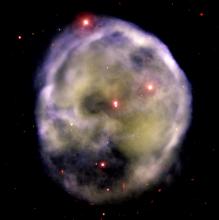Listen to today's episode of StarDate on the web the same day it airs in high-quality streaming audio without any extra ads or announcements. Choose a $8 one-month pass, or listen every day for a year for just $30.
You are here
Galaxy Pair
Two beautiful spiral galaxies in the constellation Cetus are getting each other all stirred up. The galaxies are about half a million light-years apart — not very far on the galactic scale. At that distance, the gravity of each galaxy tugs heavily at the other. That has warped at least one of the galaxies, and triggered the birth of many new stars in both of them.
Messier 77 and NGC 1055 are about 50 million light-years from Earth. Both are giant spirals like our home galaxy, the Milky Way. NGC 1055 is about the same size as the Milky Way, while M77 appears to be a good bit bigger.
We see M77 almost face-on, so we have a good view of its spiral arms and the wide bar of stars in its middle. On the other hand, we see NGC 1055 almost edge-on. We don’t see its middle as clearly, but we have a good view of waves that ripple across its disk.
The waves probably were created by the interaction between the two galaxies. That interaction has compressed giant clouds of gas and dust. The clouds have collapsed and given birth to new stars. Many stellar nurseries are visible in both galaxies — the birthplaces of millions of new stars.
The galaxies are in Cetus, the whale or sea monster. Cetus is in the southeast as night falls, to the right and lower right of the almost-full Moon.
Script by Damond Benningfield





